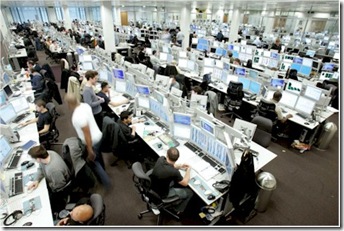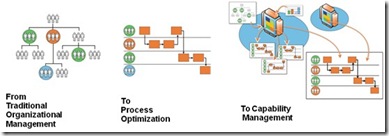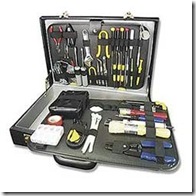I presented at a senior management board for a major investment bank on mobile technology a few years back. Part way through, the CIO interrupted and started my critique for being out of touch with the realities of their business and the requirements of the trading floor. Thinking I had totally missed the mark, I was saved by someone who jumped in and started confronting the CIO. He said, ‘where do you think our top traders work out of? Our City offices?? Not a chance. They are in Monaco, Jersey, Cayman Islands, Gibraltar. I can’t remember the last time I saw them in the office.’ ‘And it not just the big guys either,’ he continued, ‘more and more if we want to attract the very best and brightest out of schools, these hot shot kids are demanding these fancy new technologies that they have grown accustomed to in university. If we don’t offer them, then they question if we really all that sophisticated and ‘world leading’ as we claim and they opt to go work some place else more dynamic.” The interloper was the Head of Trading who had invited me to speak and set up the topic in the first place to shake things up and drive more innovation in the business on new ways of working.
Month: September 2009
First Kill All the Office Buildings
A while back I met with our Victoria Melville of PR firm Inferno (now setting up her own firm Melville Communications) who told me about their plans to move offices from their currently White City location. My first question was, ‘Why have offices at all?’ She was a little surprised by such a straightforward question. The ensuing conversation went something like this…
“Why do you need offices. Half the time you are on the road meeting with customers and press and other times you do work from home anyway.”
“Well, I like to go into the office to see other people I work with.”
“Okay, when is the last time you went into the office?”
“About bit over a week ago.”
“And, when you were there, how many people were there for you to see or were they all out with customers, etc.?”
She just smiled in response and acknowledged that the office was mostly empty on the day she went in. So, Inferno, like so many companies, were paying expensive London rates and ongoing running costs for empty office space that occasionally drew people in for a gratuitous car journey to meet with people who weren’t there. Ironically, when Victoria did visit the office, she ended up not spending much time with or even sitting near other colleagues that were there because their desks were scattered and everyone gravitated to their own, fixed desk to do their work.
My argument is not that people shouldn’t come together to see one another face to face. My argument was to put all of the money currently spent on rent, rates, lighting, air conditioning into setting up periodic gatherings that are (a) focused on the coming together piece, and (b) are not mundane experiences in conventional offices, but with all the money saved could be exceptional experiences. Comfortable chairs in an elegant room of a museum rented out for a few hours with some tasty catering brought in. Now that’s a day at the office. That’s a great environment for interacting with colleagues. And that’s a lot cheaper than the commuting and space renting of the current mode.
Virtual Parallels
Curiously, and perhaps not coincidentally, the same dynamics moving towards distributed working in the flesh-and-blood, bricks-and-mortar workplaces is also taking place in the bits-and-bytes of digital world.
One of the hottest concepts or trends in computing right now is ‘Service Oriented Architecture’ (SOA). At its heart, SOA is a collection of principles, guidelines and concepts (ie. the ‘architecture’ bit) that one needs to consider or adopt in order to exploit the flexibility that ‘service’ delivered software introduces. Traditional or conventional software implies a more centralised command-and-control structure where the computing is installed on the device where it is going to be consumed (sort of like a worker who is going to do work in the workplace where they are based) A ‘service’ orientation implies a results-delivery structure where the results of the computing are delivered to the user but the computing itself might be done on some computer where the use as not installed anything, the user just consumes the output of the computation.
Who Is Driving
Given these drivers (energy, climate, social, intellectual), there are a number core constituencies who have an acute interest in these considerations and who will be on the vanguard to driving for change.
Energy/Climate: Public Policy is increasingly re-examining the rules and assumptions of the 21st century economy with energy supply and climate change in mind. Tax incentives and penalties are being introduced to reduce carbon footprints especially from motor vehicles.
Social: Women/Families – Pressures at breaking points are driving people to demand greater flexibility in working practices (eg. hours, locations) in order to juggle it all. One organisation at the forefront of these reforms is Working Families.
Knowledge work: Top Talent – The constituency with the most to gain by reducing brain dead commute time are those for whose hour of concentrated knowledge work has the highest valuation, ie. professionals with scarce skills. More specifically it is the highest performers. Not only is their domain expertise scare, but their exceptional competency is even more scarce.
The New Tools
It’s not just a range of pressures that are driving people to these new modes of work, but it is also a wealth of enablers that have emerged to unleash the potential for resolving these pressures in unprecedented and innovative ways.
Asynchronicity – The operative production model of the 20th Century was the serial, synchronous ‘assembly line.’ All of the resources for production lined up in one space and one shift. As knowledge work developed, this model continued to predominate with processes for planning, approving, assessing, etc. moving from mail tray to mail tray in just as methodical a fashion as a Model-T trundling down the line. The operative production model of the 21st Century is asynchronous parallelism. Email communication that can be read and responded to today, tomorrow or next week. Collaborative documents where multiple parties contribute.
Communications – A pervasive, increasingly flexible and capable communications network becomes the hub that unites the diverse pieces. It is not just the digital network that it the Internet, but it is also the increasingly sophisticated capabilities developed on top of it, the increasingly varied devices attached to it and the increasingly diverse contexts to which it has been applied.
Modern Management Principles – Knowledge work predominant in the service economy of the 21st century is much more results based than its manufacturing, production-line focus on activity. Modern management concepts like Peter Drucker’s ‘Management By Objective’ (MBO) harnesses approaches critical to the new modes of flexible working.
Preserving the World’s Assets
A number of megatrends are all converging to drive this move out of concentrated workplaces towards more distributed work. All of these drivers are centred on preserving key and increasingly precious assets to the global economy.
Energy Assets: Peak Oil – Concern is growing to new levels about world oil supply. While eternal optimism abounds in the world’s ability to out innovate and out discover the depletion of existing sources, recent evidence is that the new finds are smaller and fewer, the existing supplies are less accessible and less productive (eg. more energy input is required extract and refine). The commodity of oil is not just a unique energy source in its combination of power and safe transportability, but it is also a critical substance in plastics, construction materials and range of everyday substances and its increasing scarcity represents a major pinch point to global economic health.
Ecology Assets: Climate Change – If the economic costs of oil-supply and demand don’t hit us in the wallet, then the environmental costs of greenhouse gas emissions will hit us there and elsewhere. Not much comment needed on the profile and intensity of this issue. But in terms of what we can do about it one of the most prominent sources of emissions is automobile commuting. 54% of US petroleum used is consumed by automobiles and in commuting to work, the average number of passengers-per-vehicle is 1.1.
Social Assets: Dual Income Social Pressures – One of the most significant contributors to post-war growth in the Western world has been new entrants to the labour force, especially women. While this infusion of economic muscle has been a boon to the second half of the twentieth century, the social consequences of this mass rise of two income families combined with longer and longer commuting to places of work (fewer people live and work in the same city or town), means less parental time to manage the household and intensifying demands to juggle work and home life responsibilities.
Intellectual Assets: Rise of Knowledge Work – Assuming we have enough power to continue running the machines we have invented and propagated to handle brute force and routine tasks, the value-add work that human beings do gravitates increasingly to creative pursuits employing intellectual capital. Increasingly people are recognizing the intellectual waste from sitting in a car and the upsides of each person finding places and environments most suited to their own individual inspiration (a library, a quiet den, a retreat, a café, etc.). MSNBC recently reported (http://www.msnbc.msn.com/id/20829879) people lose on average 1 week per year ‘sitting in traffic…and it is getting worse’ costing the USA $78 billion.



